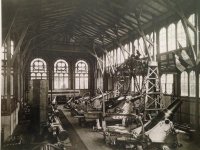Peter S
Diamond
- Joined
- May 6, 2002
- Location
- Auckland, New Zealand
I heard of Krupp making some large steel casting for an exhibition - I think it was a couple of tons and around 1850.
I have a non-technical book about Krupp which says the firm sent a 4,300lb cast steel ingot (cast in one piece) to the 1851 Great Exhibition in London. The author reckons 98 crucibles of steel were poured simultaneously. I believe the steel casting was also forged, the result being a gold medal-winning entry.
I don't think Alfred Krupp was doing anything novel (except perhaps size and quality), he was using the already old system of producing crucible steel. Later Krupp was an early adopter of the Bessemer converter (troublesome, the resulting product caused Krupp guns to explode and his famous forged steel railway tires to be rejected) then success with the Siemens open-hearth furnace process.
BTW, later exhibition's displayed progressively larger steel castings, for example apparently a 100,000lb steel casting fell through the wooden floor and crashed into the basement below at the 1855 Paris World Exhibition. Everyone (except Alfred Krupp who suffered a nervous break-down) was very impressed!
FWIW, here is a snippet (1967) claiming an early use (1862) of the Siemens process for steel casting in Britain. When Joe mentioned a "viable" process, I was thinking along these lines....economically viable that is.
I have a poor knowledge of this subject, so consider it all a few random comments, possibly wrong.

A 105,000lb steel ingot on the Krupp display, Vienna 1873. It's a bit hard to see, on the left. This would have been shortly after the Franco-Prussian war, Krupp triumphant!



